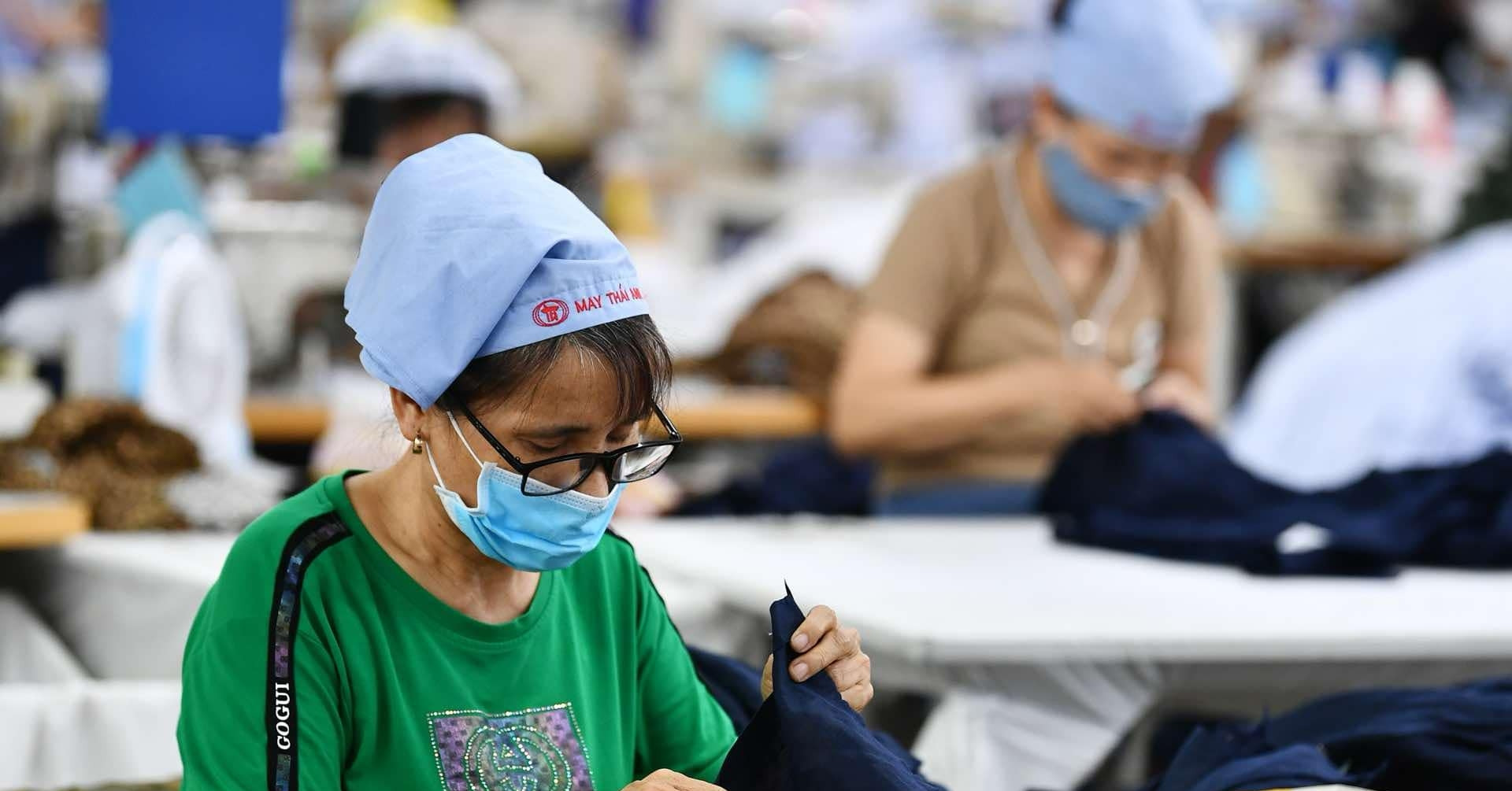 |
| Export turnover of goods in July 2023 is estimated at 29.68 billion USD, up 0.8% over the previous month. (Source: CT) |
Accordingly, in July, the total import and export turnover of goods is estimated at 57.21 billion USD, up 2.5% over the previous month, but still down 6.7% over the same period last year.
In the first 7 months of 2023, the total import and export turnover of goods reached 374.23 billion USD, down 13.9% over the same period last year; of which, exports decreased by 10.6% and imports decreased by 17.1%. Because imports decreased more sharply than exports, the economy continued to have a trade surplus.
The trade balance of goods in the first 7 months is estimated to have a trade surplus of 15.23 billion USD, a sharp increase compared to the 1.34% of the same period last year. Of which, the domestic economic sector had a trade deficit of 12.58 billion USD; the foreign-invested sector (including crude oil) had a trade surplus of 27.81 billion USD.
Specifically, the export turnover of goods in July 2023 is estimated at 29.68 billion USD, up 0.8% over the previous month; of which, the domestic economic sector reached 7.76 billion USD, down 1.8%; the foreign-invested sector (including crude oil) reached 21.92 billion USD, up 1.7%.
However, compared to the same period last year, the export turnover of goods in July decreased by 3.5%. In the first 7 months of 2023, the export turnover of goods is estimated at 194.73 billion USD, down 10.6% compared to the same period last year.
Of which, the domestic economic sector reached 51.5 billion USD, down 10.2%, accounting for 26.4% of total export turnover; the foreign-invested sector (including crude oil) reached 143.23 billion USD, down 10.8%, accounting for 73.6%.
In the first 7 months of 2023, there were 30 items with export turnover of over 1 billion USD, accounting for 91.6% of total export turnover; of which, there were 5 items with export turnover of over 10 billion USD, accounting for 57.6%.
On the other hand, the import turnover of goods in July 2023 is estimated at 27.53 billion USD, up 4.4% over the previous month; of which, the domestic economic sector reached 10.73 billion USD, up 14.3%; the foreign-invested sector reached 16.8 billion USD, down 1%.
Meanwhile, compared to the same period last year, import turnover of goods in July decreased by 9.9%; of which, the domestic economic sector increased by 0.4%; the foreign-invested sector decreased by 15.4%.
In the first 7 months of 2023, the total import turnover of goods is estimated at 179.5 billion USD, down 17.1% over the same period last year. Of which, the domestic economic sector reached 64.1 billion USD, down 16.1%; the foreign-invested sector reached 115.4 billion USD, down 17.7%.
Regarding the structure of imported goods in the past 7 months, the General Statistics Office said that the group of production materials is estimated to reach 168.3 billion USD, accounting for 93.8%; of which, the group of machinery, equipment, tools and spare parts accounts for 43.9%; the group of raw materials, fuels and materials accounts for 49.9%. The group of consumer goods is estimated to reach only 11.2 billion USD, accounting for 6.2%.
Regarding the import and export market of goods in the first 7 months of 2023, according to the General Statistics Office, the US is Vietnam's largest export market with an estimated turnover of 52.4 billion USD. China is Vietnam's largest import market with an estimated turnover of 58.6 billion USD.
In the first 7 months of 2023, Vietnam's trade surplus with the US is estimated at 44.3 billion USD, down 24.1% over the same period last year; trade surplus with the European Union (EU) is estimated at 16.4 billion USD, down 11.9%; trade surplus with Japan is 0.9 billion USD (in the same period last year, trade deficit was 0.4 billion USD).
The General Statistics Office said that many of Vietnam's key export products are facing difficulties due to a sharp decline in global market demand. The economy's continued large trade surplus raises concerns that industrial production and exports will continue to face difficulties in the coming time. The reason is that Vietnam's economy depends heavily on imported raw materials, but the decrease in imports shows that businesses are still lacking orders, so there is no need to import input materials.
In the coming time, to further improve the efficiency of import and export, the Ministry of Industry and Trade has determined to focus on implementing a number of tasks such as promoting innovation and enhancing trade promotion activities towards new markets, potential markets such as India, Africa, the Middle East and Latin America, Eastern Europe... and markets that are less affected by inflation and have positive growth (ASEAN).
In addition, effectively exploit Free Trade Agreements (FTAs); Facilitate and enhance digital transformation in the issuance of preferential Certificates of Origin (C/O), thereby supporting businesses to take advantage of commitments in FTAs.
Director of the Department of Trade Defense (Ministry of Industry and Trade) Trinh Anh Tuan said that in the context of international economic integration, domestic production and export industries must constantly improve their competitiveness and improve production organization methods to be able to compete equally with imported goods right in the domestic market.
In addition, the Ministry of Industry and Trade also closely monitors and implements trade defense activities based on the requirements of the domestic manufacturing industry, to prevent unfair competition of imported goods in accordance with legal regulations and international commitments.
Furthermore, the Ministry of Industry and Trade has been coordinating with relevant associations and units to closely monitor the production and import situation to promptly take appropriate measures to protect the legitimate rights and interests of domestic manufacturing industries.
Source





























































Comment (0)